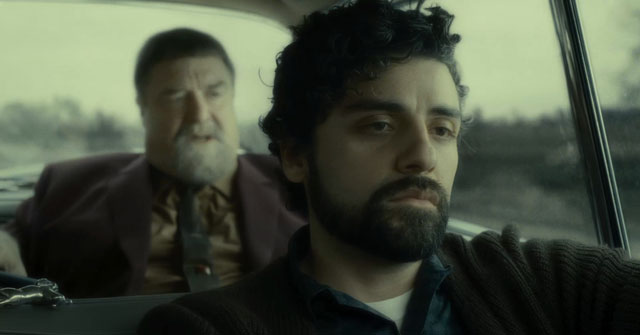Inside Llewyn Davis – Film Review
Reviewed by Damien Straker on January 6th, 2014
Roadshow Films presents a film by Joel and Ethan Coen
Written by Joel and Ethan Coen
Starring: Oscar Isaac, Carey Mulligan, John Goodman, Justin Timberlake and Adam Driver
Running Time: 105 minutes
Rating: M
Release Date: January 16th, 2014
Joel and Ethan Coens’ brilliant new film Inside Llewyn Davis is inspired by Brooklyn folksinger Dave Van Rork’s memoir The Mayor of MacDougal Street and stands as some of their very best work. Though the film is not autobiographical, it is also about a New York folksinger named Llewyn Davis, played with hilarity and sizeable heart by Oscar Isaac, who in 1961 is struggling as a solo artist. The film follows him for one week, watching as he stresses his independence and professionalism but still opts to sleep on other people’s couches. While he’s also miserable after a tragedy involving his former singing partner, he persists with trying to sell his own solo music instead of entering a folk group.
This is a fascinating cultural period and approached with great authenticity. Folk music in America was considered in the 1950s to be politically left leaning and because of this it was forced underground into clubs and cafes during the McCarthy Red Scare days. Between the end of the 1950s and early 60s, folk music was revived by less politically active and more commercial groups like The Kingston Trio, who dominated the music scene prior to the British Invasion that would introduce pop and rock music to the world. This was also an era in America where society was divided between people of deep conservative values and those who considered themselves artists but struggled to find steady employment that could support their creative ambitions.
Another interesting layer to this material is its reflection of the Coens’ defiance of the Hollywood studio system, the commercialisation, and their persistence for uniqueness. The Coens were born in the 1950s in Minnesota with Jewish heritage. Both have university degree, which includes Ethan’s background in philosophy. They now live in New York and each of their films continues to satirise the different facets of American culture, including Hollywood itself. Many of their projects are genre films, which means they use a set of existing film tropes and then subvert these conventions in funny and sometimes bizarre ways. At a time when Hollywood films are generally lazy and complacent, their resistance to ever make the same film twice, shifting effortlessly between crime, comedy and drama, and sometimes mixing all three, is invaluable. The public’s interest in their idiosyncrasies is reflected in the Coens’ glowing box office results. They are proof that filmmakers can retain their own unique auteurist imprint while still remaining commercially viable – perhaps a similar desire to the title character of this very film.
Inside Llewyn Davis excels in being unique because the excellent, original screenplay by the brothers deliberately sidesteps conventional narrative beats at crucial turns. One of the main plot lines is that Llewyn is looking after a friend’s cat. Its name is Ulysses, which is our first clue that the film is distinctly Joycean in its narrative structure. Llewyn’s odyssey isn’t to make him a more likeable or less stubborn person but to introduce him to a series of characters who he fears that he will have to depend on. In its drifting trajectory, the film is foremost of a crisis of personal grief and a resistance to personal and cultural connections. This very resistance is tested by Llewyn’s low economic status and his poor relationship choices. Staying on the floor of a friend’s house, he learns that Jan (an unusually fierce, angry Carey Mulligan), the girl he has been sleeping with, is pregnant and it’s possibly his child. She’s married to Jim (Justin Timberlake) and they sing together. Potential moments of success for Llewyn, including a long road trip into Chicago, where he meets a drug addicted jazz singer (played by John Goodman), cleverly subvert our expectations and deepen the sense of isolation. Many of these vignettes meet justifiable dead-ends and free themselves from easy sentimental resolutions because the central character refuses to embrace change and continues to resist cultural, artistic and emotional conformity.
The Coens’ technical work, from their entire production team, is on the whole faultless. The 60s of New York is recreated with such stunning attention to detail that it could be a photo representation of the time period. As this is the early part of the decade, traces of the 1950s and its reserved mood are still visible, long before the flamboyance of the new era emerged. The blistering winter storms are frightfully atmospheric and the entire colour scheme is washed out with a grey desaturated lens. This is true to the thematic core of the film of a man’s detachment from other people and the changing time period he won’t embrace. The way that the static camera cuts from long shots of narrow corridors and winding roads to tight close-up shots of faces is also reflective of Llewyn’s stubborn narrow-mindedness and unchanging ways. In the outstanding opening scene, the camera focuses tightly on a single microphone to show his singularity, while other characters seem to disappear into the deep and smoky shadows of the audience. The costumes, including Llewyn’s drab, thin attire, unsuitable for winter weather, is contrasted with people who have adopted more formalised suits, are also true to his cultural resistance.
Oscar Isaac gives his best performance so far, with a role that requires a comedic touch and moments of subtle internal pain. His glum, hangdog face is a perfect fit for the quiet, often hysterical deadpan comedy that the Coens have mastered. Yet there are also times when his grief is quietly visible, as he tries desperately to contain his emotions from surfacing. Isaac performed his own live singing, working under the film’s music producer T. Bone Burnett, and as expected the music is often stirring. Even in the smallest roles, the cast from Justin Timberlake, Carey Mulligan to Adam Driver, are memorable additions. The only fault with the film is that on my initial viewing the ending didn’t quite sit as comfortably as the rest of the film with its deliberately circular structure. Is it literal or metaphorical or both? What would a Coen brothers’ film be though without a bizarre finish? It’s who they are.
Summary: A fascinating cultural period and approached with great authenticity









